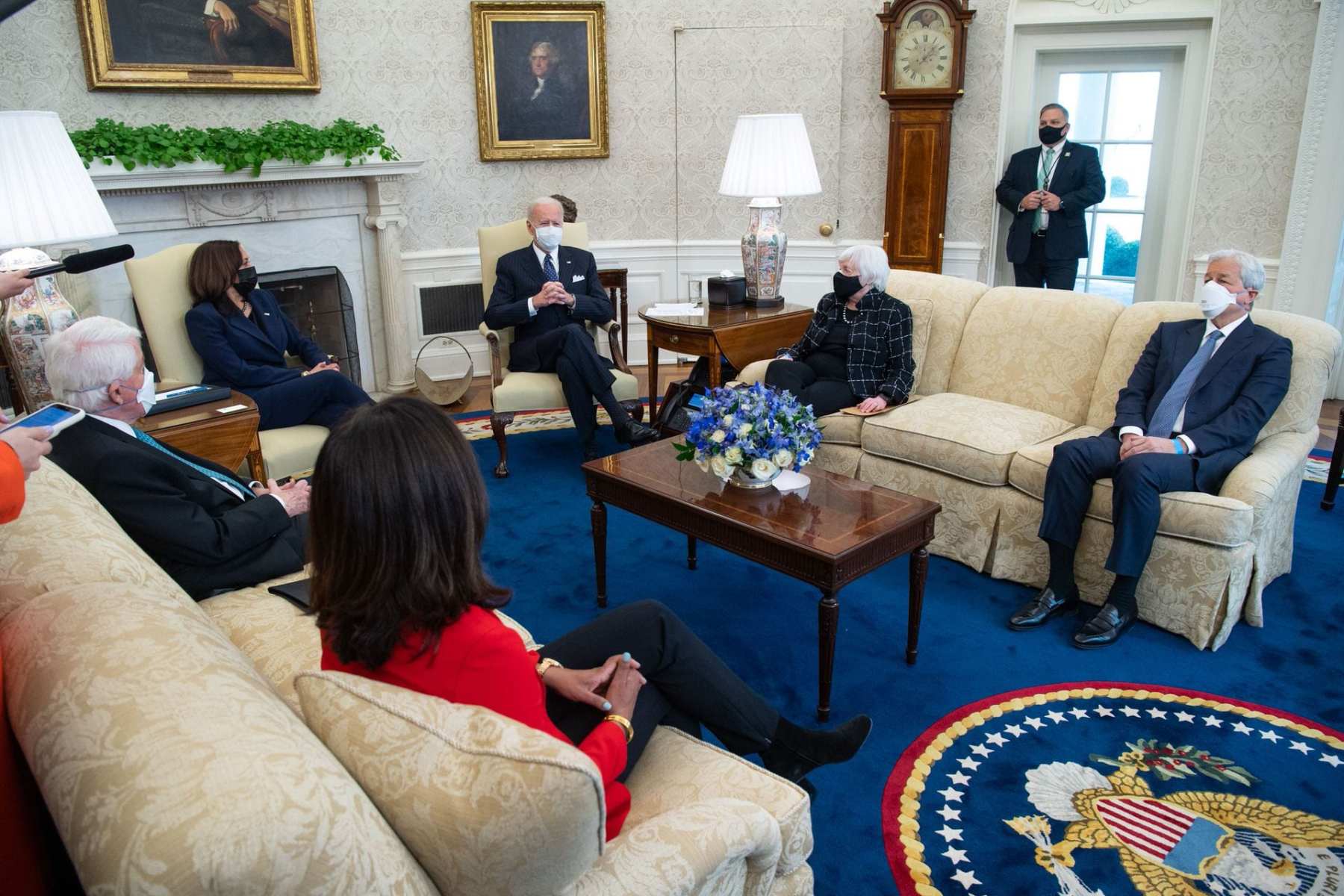The Senate on Saturday voted to approve the $1.9 trillion American Rescue Plan package from President Joe Biden’s administration, designed to deal with the coronavirus pandemic and related economic pain in a way that also furthers equity.
The House voted a week earlier on a version of the package, which included a provision to raise the federal minimum wage to $15 an hour. That proposal is not in the Senate version of the bill. The Senate parliamentarian advised that it did not meet the requirements outlined by the budget reconciliation process Congress is using the pass the measure, which allows it to pass with 50 votes in the Senate instead of 60 but requires that each element directly impact the budget in the short term. A second proposal from some Senate Democrats to require large corporations to pay a higher minimum wage was also scrapped.
The Biden administration wants to pass the new relief package by March 14, when the benefits of the last round of relief, passed in December, are set to expire. The House still must vote again on the Senate version.
No Republicans voted for the package in the House, and two Democrats voted against it. In the Senate, the votes broke along party lines, but Republican Sen. Dan Sullivan of Alaska was absent and so it did not need Vice President Kamala Harris’s tie-breaking vote.
Contained in the stimulus proposal is a plan for vaccinations, support for workers and businesses and a $1,400 check to most households. Many of the measures in the bill will attempt to address long-standing racial and gender disparities laid bare by the pandemic. Here are some of the key parts of the bill:
Vaccinations
The package about $14 billion for vaccines, including a program to create community vaccination centers and deploy mobile vaccination units to reach underserved populations and people who are undocumented. This is to work toward the administration’s goal of 100 million shots in 100 days. The administration administered 50 million shots within 37 days.
Biden also wants to expand testing, allocating an additional $50 billion toward that goal, with funding for more rapid tests and more robust testing protocols at schools and within local governments.
That package allocated $19 billion to expand the public health workforce, which would involve vaccine outreach and contact tracing — also critical areas, especially as experts worry that vaccine skepticism and misinformation could deter women from getting the injections.
School reopenings
The plan allocates $130 billion for K-12 school reopenings and other policies to make reopening safer, including reducing class sizes, modifying classrooms for social distancing, providing more protective equipment, enhancing school access to nurses and providing more technological infrastructure for students to address inequalities.
Another $35 billion in funding will go to public higher education to also execute coronavirus mitigation plans, such as implementing public health protocols and distance learning plans.
Child care
The child care industry will get a $24 billion infusion of emergency funds to help stabilize the industry, helping day care providers pay rent, utilities and payroll, plus assistance to help fulfill coronavirus guidelines around social distancing and protective equipment. Those funds would be in addition to the $10 billion Congress allocated in December.
The bill also includes $15 billion in additional funding for the Child Care and Development Block Grant Program, which provides funding for states to subsidize child care for low-income families with children under the age of 13. The additional funds will help essential workers, low-wage workers and those who have experienced job interruptions as a result of the pandemic.
Child tax credit
The child tax credit will be expanded to as much as $3,600 per child for families with children under the age of 6, up from the current maximum of $2,000. Families with children ages 6 to 17 would get $3,000 per child.
The credit would become refundable, a longtime goal of Rep. Rosa DeLauro, so low-income families who have particularly struggled to access child care this year can get the full funds. Right now, families who have no tax liability after deductions can claim only a maximum of $1,400 of the full $2,000 credit.
Initially, the administration wanted to move to a monthly option, allowing parents to access the funds through a check every month instead of one every year. Instead, the bill was reworded so the Internal Revenue Service distributes the funds “periodically” from July to December of this year. That means parents could get half of the 2021 credit in advance this year and half when they file their 2021 taxes next year.
DeLauro said she wants to see the change become permanent following the passage of the stimulus package.
The measure is considered one of the most effective ways to reduce child poverty. Estimates from the Center on Poverty & Social Policy at Columbia University have found that the expanded tax credit could cut child poverty by about half.
Unemployment
Federal unemployment insurance of $300 a week expires March 14, driving the timeline of the vote to ensure workers do not go without federal aid. Biden initially sought to expand those benefits to $400 a week, but Senate Democrats have agreed to change that figure to $300 a week and extend the benefits through September 6.
Individuals will also receive $1,400 stimulus checks, but the parameters of who can get them have changed. Those earning $75,000 a year, a single parent earning $112,500 or a couple making $150,000 qualify for the full amount.
But the point at which it starts to scale down has changed. Before, the amount would decrease until zeroing out for people making $100,000. Now that threshold is $80,000 for an individual and $160,000 for a couple.
White House spokeswoman Jen Psaki said 98 percent of the people who received the $600 December stimulus will receive the new $1,400 checks.
Food insecurity
The December stimulus bill increased benefits for SNAP — the Supplemental Nutrition Assistance Program — by 15 percent for six months. Experts applauded that change, which research suggests is one of the most effective ways to address hunger. But many worried it wasn’t enough, especially with the six-month drop-off.
The package extends the SNAP increase through September 2021. The package also commits to backing the 15 percent SNAP increase — roughly $25 per person per household, each month — as long as the pandemic persists.
Beyond SNAP, Biden’s plan would put $3 billion more into the Special Supplemental Nutrition Program for Women, Infants, and Children, also known as WIC, and provide an additional $1 billion benefit to address food insecurity in Puerto Rico, American Samoa and the Northern Mariana Islands.
Addressing gender-based violence
The package also includes $800 million for federal programs that protect survivors of gender-based violence and child abuse. The administration is hoping to provide additional resources to curb the rise in domestic violence and sexual assault that has been exacerbated by the pandemic, creating a “shadow pandemic” for women, girls and members of the LGBTQ+ community.
The bill allocates $200 million for sexual assault programs; $200 million for the Family Violence Prevention and Services Act, which provides emergency assistance for victims of domestic abuse; and $50 million to support domestic violence and sexual assault programs in communities of color. An additional $350 million will go to grants that help prevent child mistreatment and shore up state child welfare programs.
“For women and families experiencing domestic violence or sexual assault, the crisis is far from over—and these funds will go a long way in helping to ensure they can stay safe, seek justice and heal,” said Washington Sen. Patty Murray, who helped advocate for the funding.
Rent relief
The package includes about $27 billion in aid aimed at helping hard-hit workers pay rent, water and energy bills. That’s in addition to $25 billion allocated in the last relief bill. Another $5 billion would go to finding housing for those experiencing homelessness and $10 billion would go to homeownership assistance to help homeowners behind on their mortgage payments avoid eviction or foreclosure.
Paid leave
The bill includes a tax credit for businesses that offer leave to their employees, making it optional.
What is out
Some provisions in the Biden administration’s proposal are out of the version the Senate voted on:
On rent relief: The package will not include an extension of the eviction moratorium set to expire at the end of March. Like with the minimum wage, the eviction moratorium did not fit within the confines of the budget reconciliation rules and was also left out of the bill under the advice of the parliamentarian.
On paid leave: Paid leave was another policy that did not pass muster with the parliamentarian and will not be included in its entirety in the final bill.
The pandemic relief CARES Act that passed in March instituted a national emergency leave policy with the hope of keeping sick workers out of the workplace and limiting the spread of the virus. But many of those provisions, which aided some 80 million workers nationwide, expired at the end of last year.
Biden’s plan would have reinstated and expanded the paid leave policy first put forth early last year. The president asked Congress to reenact the policy through September 30, but without the exemptions carved out in the CARES Act that omitted the requirement for employers with more than 500 employees or less than 50 employees. The proposal would have offered 14 weeks of paid sick, family and medical leave, including for workers who are caring for children after a day care center closed. The leave would have been 100 percent refundable to employers with fewer than 500 employees.
Last year, about 700,000 parents — two-thirds of them working mothers — left the labor force because they needed to care for a child.
Democrats are hoping to include the paid leave provisions first proposed for this package in the upcoming jobs plan the Biden administration is expected to unveil next.
On minimum wage: The proposal to raise the minimum wage would have gradually increased the current pay floor from $7.25 to $15 an hour by 2025. The minimum wage hasn’t increased since 2009. A report by the nonpartisan Congressional Budget Office found that increasing the minimum wage could raise the income of 17 million workers, but at a cost: 1.4 million workers would lose their jobs. About 900,000 people would be lifted out of poverty. Women, who make up two-thirds of the 40 lowest paid jobs in the country, would stand to benefit the most. The proposal would have also included an elimination of the federal tipped wage, which is $2.13 an hour. Women make up about 70 percent of tipped workers.





